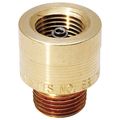If you’re planning on selling a home in the Minneapolis or Saint Paul area, there is a good chance you will need to have a home inspection done before you sell your house (possibly several). There are two types of home inspections, private and city. Today I’ll talk about city inspections.
City inspections are required in 14 metro cities, including Minneapolis and Saint Paul. At the Truth in Housing page I have a full list of these cities with specific requirements for each city. These are inspections that must be done by a city employee or sub-contractor for the city before the house is sold, and in many cities, before the house is even offered for sale. Some cities, such as Saint Louis Park, do code compliance inspections and require repairs to be made on things that aren’t up to code. Other cities, such as Maplewood, require only a disclosure report, and no repairs ever need to be done.
These reports are commonly referred to as Truth in Housing, Time of Sale, or Point of Sale inspections, among many other terms. I am calling these ‘city inspections’ for lack of a better term – it would be nice if every city could call their inspections the same thing. While on that topic, it would also be nice if every city had the same requirements! In Minneapolis, you need a working smoke detector on every level of the home. Bloomington requires the same, plus a working detector in every bedroom. In Saint Paul, you only need one working smoke detector in the home, but it needs to be hardwired.
Even though each city has specific requirements, there are some items that are fairly universal to all the cities that have repair programs:
 Vacuum Breakers – aka backflow preventers. This is a device that can be purchased at most hardware stores, and should be screwed onto the end of any exterior sillcocks, or indoor faucets that could accept a garden hose thread (typically the laundry faucet). These are basically one-way valves that protect the city’s water supply from potential contamination. Note the set screw in the vacuum breaker pictured to the right – this set screw should be tightened down until broken off to make sure the vacuum breaker is permanently installed.
Vacuum Breakers – aka backflow preventers. This is a device that can be purchased at most hardware stores, and should be screwed onto the end of any exterior sillcocks, or indoor faucets that could accept a garden hose thread (typically the laundry faucet). These are basically one-way valves that protect the city’s water supply from potential contamination. Note the set screw in the vacuum breaker pictured to the right – this set screw should be tightened down until broken off to make sure the vacuum breaker is permanently installed.- Smoke Detectors are recommended in every bedroom and one in a common area on every level, such as a hallway. Take time to test every detector in the house, install new batteries if needed, or replace the detector if defective. Smoke detectors should ideally be located on the ceiling in the middle of the room, and never closer than four to six inches to a wall if mounted on the ceiling. If mounted on a wall, follow the manufactures instructions for location.
- Plumbing leaks and electrical hazards make up a large portion of the repair items. Before having your inspection, take time to make sure there are no leaking plumbing fixtures. To test the sink, fill the sink up with four inches of water, and then let it drain. Look underneath with a flashlight to make sure there are no small drips, and also check the faucet handles for leaks – laundry faucets are the most common offenders. To ensure no electrical issues, replace any missing cover plates at outlets and switches – check the outlet behind your fridge too! Make sure there are no permanently installed appliances running on extension cords – the most common offenders are garage door openers and water softeners.
While these items make up only a small portion of what I look for during city inspections, these are certainly some of the most common repair items, and are often some of the easiest items to take care of ahead of time. Feel free to contact me for any specific questions about these requirements.
Reuben Saltzman, Structure Tech Home Inspections – Email – Truth in Sale of Housing Evaluator
